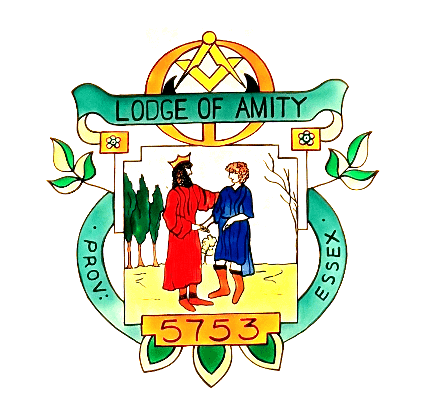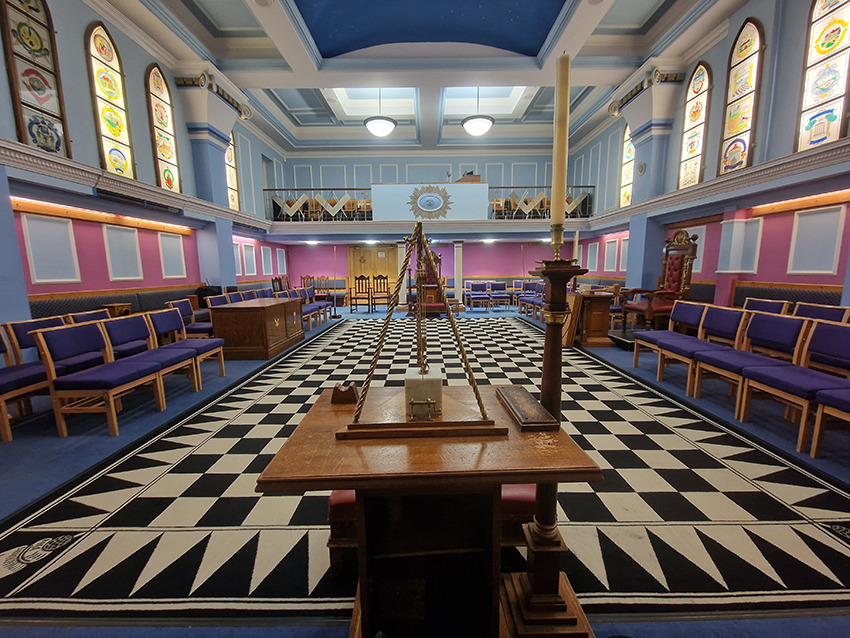
Lodge of Amity 5753
Meets at Saxon Hall, Southend on Sea, Essex SS2 6UN
Our main meeting dates are:
The second Wednesday in April and December
The third Wednesday in June and September
Lodge of Instruction meetings are held on Thursday evenings from September until June.
For more information please contact our secretary Colin Towle by e-mail: colin.to1946@gmail.com

Lodge History
It is often difficult for any of us to fully appreciate why an organisation came into being as our perception of such events is moulded by our own personal experiences of life and more especially the conditions under which we live at present. We know that the origins and early development of Freemasonry remain a matter of some debate and conjecture, with some claims that it dates back over one thousand years. However within medieval operative Lodges many members attempted to help each other when difficulties were experienced and thus it is not surprising that one element of Freemasonry became support for others. It is also a fair reflection on life to deduce that throughout the millennia, politics and religion have caused and continue to cause arguments and conflicts. Hence it can be no surprise that such topics are not part of Freemasonry and thus it appeals to all nationalities and cultures.
After the Plague towards the end of the 15th century England experienced some 200 years of suffering, during a series of wars and religious and political conflicts, until the monarchy was restored under Charles II in 1660 after the short lived Commonwealth of England. The Grand Lodge of London and Westminster, later called the Grand Lodge of England, was founded on 24th June 1717 whilst the Ancient Grand Lodge of England was founded on 17th July 1751; both uniting to form the United Grand Lodge of England on 25th November 1813.
English Freemasonry flourished in the early 1800’s and during the reign of Queen Victoria her eldest son, the then Prince of Wales, was an active Freemason. This popularity further increased during and after World War I when the sons of George V were prominent Freemasons. Our Royal connection is still maintained as His Royal Highness the Duke of Kent is our current Grand Master.
When the idea of the Lodge of Amity was first put forward more Lodges were needed to meet the increasing demand. The first trace of our history can be found in 1935 when members of several Lodges pursued Masonic knowledge at and were members of The Amity School of Instruction. Early discussions on the possibility of forming The Lodge of Amity took place in 1937 and it was founded on 30th November 1938. Then the world was then a far different place to the present day, the Victorian workhouse being in existence until its demise in 1948 about the same time that the National Health Service came into existence. A very low state pension of 25p per week had only been introduced in 1909, whilst the concept of a welfare state was still in its infancy. These were tough times for the poor but there were many philanthropists and after the devastation and loss of life in World War I, many men wanted to make a contribution towards the common aim of making the world a better place and create a land fit for heroes.
The Amity School of Instruction had a membership of 40, quite a few of whom, for various reasons, had difficulty in attending their own Lodges’ regular meetings. In those days all shops had an early closing day on Wednesdays and hence it is no surprise that a number of founders and members of The Lodge of Amity were shopkeepers, such that it was logical to opt for Wednesdays as a suitable meeting day.
Freemasonry however, was still for those who enjoyed an above average income as the annual subscription was 3 Guineas or £3.15 and it must be remembered that at that time the average weekly wage in the manufacturing industry was £3.45. With the average wage in 2013 of some £500 a week the cost of Freemasonry has halved since our current annual subscription is £260. In 1938 the cost of an average car was between £100 and £150, a Royal Enfield Motorcycle £35 whilst petrol was 8p a gallon, hence with petrol at over £6 a gallon in 2013 the cost of living has increased substantially in most areas.
The Lodge had only existed for a little over 9 months when the outbreak of the Second World War was declared, during which period there were many unusual events. A footnote to the minutes of the meeting held on 19th June 1940 notes that the first heavy air raid on Leigh-on-Sea took place during the previous evening and by the autumn of 1940 some of the heaviest activity of the Battle of Britain was taking place. The meeting scheduled for 18th September 1940 had to be cancelled at the last minute no doubt caused by a change of tactics by the Luftwaffe. From 7th September 1940 the Luftwaffe concentrated daytime air raids on British towns and cities with 15th September 1940 now regarded as the height of the attacks. The Thames corridor in addition to London itself was under constant attack for many months and regular bombing was not curtailed until October 1940.
Movement in coastal areas was obviously restricted and this created many problems with respect to attendance at Lodge meetings. A meeting scheduled for 5th July 1944 had to be cancelled because of enemy action, one suspects because the Germans were then using the V1 missile or ‘Doodlebug’ to launch attacks on British Cities.
Post war Britain was a period of very hard work for most people as the country attempted to rebuild itself after the ravages of war and it was during this period that annual ‘Ladies Festivals’ increased in popularity. These were truly glittering affairs and the ladies spent many weeks in preparing for them, often saving ration coupons until clothes rationing ended on 15th March 1949. For The Lodge of Amity such events were in full swing by the 1960’s and it was often the case that a future Lodge member had his first contact with the Lodge at such functions. Although not part of Lodge activity Ladies Festivals still flourish today raising large sums of money for various charities and attracting new members.
The Lodge has used various venues, meeting at the Memorial Temple, Woodgrange Drive, from December 1957 to 2005, more recently moving to Saxon Hall in January 2006. These comfortable surroundings are the perfect venue for both Masonic and Social functions and the Saxon Hall Jubilee Suite is one of the finest function suites in the area. Weekly contact with each other is maintained from September to June at Lodge of Instruction, plus our four regular meetings and it is thanks to the work of all those who regularly attend our Lodge of Instruction, that The Lodge of Amity has continued to maintain its very high standards.
There are a number of family connections within the Lodge but in general Lodge members have a very varied professional background. Many events have been memorable simply because of those who have been involved and there have been some fascinating talks and presentations. The Lodge welcomed its 200th member on 8th December 2010 and at its 75th Anniversary Meeting on 30th November 2013 donated £2500 to the charity ‘Lifelites’ who provide fun and educational technology for some 9,000 children who stay, play and learn in all 49 baby and children’s hospices throughout the British Isles.
The Lodge is both Amity by name and Amity by nature and is known for the warm welcome that is extended to all its visitors. The Lodge has made a major contribution in many diverse areas but despite its many achievements, during its first 75 years, it recognises with pride the sincere debt of gratitude that is owed to its founders, who despite the difficulties imposed by the outbreak of war, endured numerous hardships and shortages in those early days to ensure that The Lodge of Amity survived. Thanks also go to the many succeeding generations whose efforts and consistency have ensured continuity. The Lodge will no doubt prosper and flourish in the next 25 years and achieve that great milestone, when with pride, it will celebrate its centenary on 30th November 2038.

